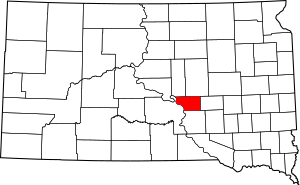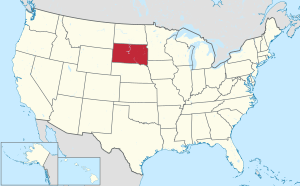Buffalo County, South Dakota facts for kids
Quick facts for kids
Buffalo County
|
|
|---|---|

Fort Thompson Big Bend Dam.
|
|

Location within the U.S. state of South Dakota
|
|
 South Dakota's location within the U.S. |
|
| Country | |
| State | |
| Founded | 1864 (created) 1871 (organized) |
| Named for | American buffalo |
| Seat | Gann Valley |
| Largest community | Fort Thompson |
| Area | |
| • Total | 488 sq mi (1,260 km2) |
| • Land | 471 sq mi (1,220 km2) |
| • Water | 16 sq mi (40 km2) 3.4% |
| Population
(2020)
|
|
| • Total | 1,948 |
| • Estimate
(2023)
|
1,884 |
| • Density | 3.992/sq mi (1.5412/km2) |
| Time zone | UTC−6 (Central) |
| • Summer (DST) | UTC−5 (CDT) |
| Congressional district | At-large |
Buffalo County is a county in the U.S. state of South Dakota. As of the 2020 census, the population was 1,948. Its county seat is Gann Valley which, at 10 people, is the least populous county seat in the United States. The county was created in 1864, and was organized in 1871 as part of the Dakota Territory.
In 2010, the center of population of South Dakota was located in eastern Buffalo County. The Crow Creek Indian Reservation, inhabited by the Crow Creek Sioux Tribe, makes up the majority of Buffalo County.
According to the 2013 Small Area Income and Poverty Estimates of the U.S. Census Bureau, about 41% of county residents live in poverty, making it the fifth-poorest county in South Dakota. This is a far higher poverty rate than the national poverty rate of 15.8%. Median household income in 2013 was $21,572, making it the lowest-earning county in South Dakota and the United States.
In March 2019, the county unemployment rate was 3.9%; its ten-year peaks occurred in December 2006 (18.1%) and December 2009 (17.2%). As of 2002[update], many homes lack kitchens and indoor plumbing.
Contents
Geography
The Missouri River flows southerly along the county's western boundary. The county terrain consists of semi-arid rolling hills, generally sloping to the south and east. Some area is devoted to agriculture. The south and west parts of the county are drained by Crow Creek, which discharges into the river at the county's SW corner. The county has a total area of 488 square miles (1,260 km2), of which 471 square miles (1,220 km2) is land and 16 square miles (41 km2) (3.4%) is water.
Major highways
Adjacent counties
Protected Areas
- Pease State Game Production Area
Lakes
- Bedashosha Lake
- Lake Francis Case (part)
- Lake Sharpe (part)
History
As first organized, the county occupied an extensive area, bounded on the north by Canada, southwest and west by the Missouri River, having Montana for a part of its northwest boundary, and comprising a large portion of the "Plateau du Coteau du Missouri", and a part of the Miniwakan or Devil's Lake. Thus, its original boundary also contained a portion of the future North Dakota, which became a separate unit when the Dakota Territory was admitted into the Union in 1889 as two separate states.
Demographics
| Historical population | |||
|---|---|---|---|
| Census | Pop. | %± | |
| 1870 | 246 | — | |
| 1880 | 63 | −74.4% | |
| 1890 | 993 | 1,476.2% | |
| 1900 | 1,790 | 80.3% | |
| 1910 | 1,589 | −11.2% | |
| 1920 | 1,715 | 7.9% | |
| 1930 | 1,931 | 12.6% | |
| 1940 | 1,853 | −4.0% | |
| 1950 | 1,615 | −12.8% | |
| 1960 | 1,547 | −4.2% | |
| 1970 | 1,739 | 12.4% | |
| 1980 | 1,795 | 3.2% | |
| 1990 | 1,759 | −2.0% | |
| 2000 | 2,032 | 15.5% | |
| 2010 | 1,912 | −5.9% | |
| 2020 | 1,948 | 1.9% | |
| 2023 (est.) | 1,884 | −1.5% | |
| U.S. Decennial Census 1790-1960 1900-1990 1990-2000 2010-2020 |
|||
2020 census
As of the 2020 census, there were 1,948 people, 497 households, and 393 families residing in the county. The population density was 4.1 inhabitants per square mile (1.6/km2). There were 570 housing units.
2010 census
As of the 2010 census, there were 1,912 people, 532 households, and 407 families in the county. The population density was 4.1 inhabitants per square mile (1.6/km2). There were 609 housing units at an average density of 1.3 per square mile (0.50/km2). The racial makeup of the county was 84.0% Native American, 14.8% white, 0.2% black or African American, 0.1% Asian, 0.0% from other races, and 0.9% from two or more races. Those of Hispanic or Latino origin made up 1.8% of the population. In terms of ancestry, 5.6% were German, and 0.0% were American.
Of the 532 households, 55.6% had children under the age of 18 living with them, 33.1% were married couples living together, 33.1% had a female householder with no husband present, 23.5% were non-families, and 19.0% of all households were made up of individuals. The average household size was 3.59 and the average family size was 4.06. The median age was 25.0 years.
The median income for a household in the county was $27,926 and the median income for a family was $28,333. Males had a median income of $38,920 versus $18,542 for females. The per capita income for the county was $11,410. About 44.4% of families and 49.3% of the population were below the poverty line, including 58.2% of those under age 18 and 36.3% of those age 65 or over.
Communities
Census-designated places
- Gann Valley (county seat)
- Fort Thompson
Unincorporated communities
- Crow Creek
- North Buffalo
- Shelby
- Southeast Buffalo
Township
- Elvira
See also
 In Spanish: Condado de Buffalo (Dakota del Sur) para niños
In Spanish: Condado de Buffalo (Dakota del Sur) para niños

